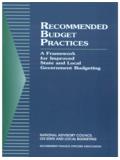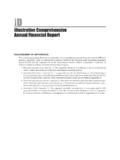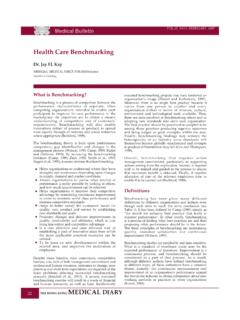Transcription of Benchmarking and Measuring Debt Capacity
1 GFOA BUDGETING SERIESV olume 1 BenchmarkingandMeasuring Debt CapacityRowan A. MirandaRonald D. PicurGOVERNMENT finance OFFICERS ASSOCIATIONC opyright 2000 by the government finance Officers Associationof the United States and Canada203 N. LaSalle St., Suite 2700 Chicago, IL 60601 All rights reservedThe text of this publication, or any part, may not be reproducedwithout the written permission of the no. 0-89125-221-5 LOC control no. 00-133081 Printed in the United States of AmericaFirst printing, June 2000 Second printing, November 2006 Third printing, February 2008 ContentsForeword.
2 ViiChapter 1. Introduction.. 1 Chapter 2. A Framework for Debt Capacity Analysis .. 11 Chapter 3. Benchmarking Techniques for Comparing Debt Burden . 21 Chapter 4. Measuring Debt Capacity .. 31 Chapter 5. Elements of a Comprehensive Debt Policy .. 45 Chapter 6. Implementing NACSLB Recommended Practices .. 59 EXHIBITS:Exhibit 1-1 Debt Capacity Analysis and Capital Budget Planning.. 5 Exhibit 2-1 Debt Capacity Analysis Framework .. 13 Exhibit 3-1 Comparative Debt Burdens .. 22 Exhibit 3-2 Debt Indicators for Peer Group Cities.
3 24iiiExhibit 3-3 Debt Burden: Relative Percentages 1994 .. 26 Exhibit 3-4 Debt Burden: Rank Order 1994.. 26 Exhibit 3-5 Comparative Debt Burden Measures: Median Values 1994 .. 27 Exhibit 4-1 Projected Break-even Year for the City of Pittsburgh .. 37 Exhibit 5-1 Elements of a Debt Policy .. 46 Exhibit 5-2 Frequency of Elements Appearing in Debt Policy Statements .. 47 Exhibit 5-3 Conditions for Debt Issuance .. 48 Exhibit 5-4 Restrictions or Limitations on Debt Issuance .. 50 Exhibit 5-5 Debt Service Limitations .. 50 Exhibit 5-6 Limitations on Outstanding Debt.
4 52 Exhibit 5-7 Characteristics, Terms, and Provisions of Debt Issuance.. 53 Exhibit 5-8 Debt Issuance Process .. 55 Exhibit 5-9 Other Forms of Debt .. 56 CHARTS:Chart 3-1 Direct Debt as a Percentage of Fair Market ValuePeer Group Benchmarking Analysis.. 23iv Benchmarking and Measuring Debt CapacityChart 3-2 Direct Debt Per CapitaPeer Group Benchmarking Analysis.. 24 Chart 3-3 General Obligation Debt Outstanding as a Percentageof Fair Market ValuePeer Group Benchmarking Analysis.. 25 Chart 3-4 General Obligation Debt Per CapitaPeer Group Benchmarking Analysis.
5 25 Chart 4-1 Annual Debt Service Per CapitaCity of Pittsburgh.. 39 Chart 4-2 Annual Debt Service as a Percent of General Fund RevenueCity of Pittsburgh.. 40 Chart 4-3 Annual Debt Service as a Percent of Budget ExpendituresCity of Pittsburgh.. 41 APPENDICES:Appendix 4-1 Projected Debt Issuance Impact .. 42 Appendix 4-2 Projected Debt Issuance Indicators for theCity of Pittsburgh: 1996 - 2024 .. 43 Contents vForewordState and local governments issue debt to finance a number of impor-tant activities from schools to infrastructure.
6 When utilized appropri-ately, the issuance of debt can lead to a more equitable tax burden acrossgenerations of citizens and taxpayers. Although most governments is-sue debt for service provision and infrastructure maintenance and sup-port, a few governments use debt to cover current operating the personal credit card of an individual consumer, debt financingcan be used to improve social welfare or to destabilize it. The keys tosound debt management relate to establishing how much debt a gov-ernment can afford and to disciplining the fiscal process by utilizing adebt and Measuring Debt Capacityis the first volume ofthe series related to the recommended budget practices of the NationalAdvisory Council on State and Local Budgeting (NACSLB).
7 This bookprovides a useful analytic approach to implementing NACSLB recom-mended budget practices on Measuring debt Capacity and implement-ing debt policies. Using a case study of the City of Pittsburgh, Pennsyl-vania, the authors illustrate how analytical techniques utilizing simplespreadsheets and data collection can produce important informationfor the design of fiscal government finance Officers association (GFOA) would liketo thank the authors for writing this publication. Rowan Miranda,GFOA Director of Research, formerly served as Budget Director for theviiCity of Pittsburgh.
8 Ronald D. Picur, Professor of Accounting at the Uni-versity of Illinois at Chicago, was formerly the Comptroller and ChiefFiscal officer for the City of Chicago. Picur is also a Partner withPandolfi, Topolski, Weiss & Co., Ltd. GFOA also thanks Mark Roukous,Deputy Budget Director, Allegheny County, Pennsylvania; DavidMiller, Associate Dean, Graduate School of Public and International Af-fairs, University of Pittsburgh; and Myles Harrington, President,MuniAuction for reviewing this publication and offering their com-ments and insights into debt issuance and capital budget authors also would like to thank Natalee Hillman for assistingwith Chapters 2 and 3 and managing the data collection effort for thestudy.
9 Andy Owens, Jason DiMartini, Salomon Guajardo, RobertRoque, and Jeff Warner, who assisted with Chapter 3 and 4; and finally,Douglas Straley, who was instrumental in collecting information forChapter 5. The authors are grateful for additional editorial assistancefrom Jennifer Douglas of the GFOA Research hope that governments can utilize and build on the techniquespresented here to implement NACSLB recommended practices relatedto debt issuance and capital L. EsserExecutive DirectorGovernment finance Officers Associationviii Benchmarking and Measuring Debt CapacityChapter1 Introduction The power to tax is the power to destroy.
10 Justice John Marshall wouldhave been as leery about the power to issue bonds had he suspectedthat, nearly 200 years later, governments could use debt for circumvent-ing short-run pressures to raise taxes or to cut spending. Today the issu-ance of debt has expanded from its traditional purpose of financing in-frastructure to underwriting private-sector initiatives ranging fromsubsidizing economic development to constructing new sports facili-ties. This book outlines an approach by which governments can evalu-ate and redesign their debt issuance policy can be a powerful governmental tool but it must be em-ployed judiciously.

















